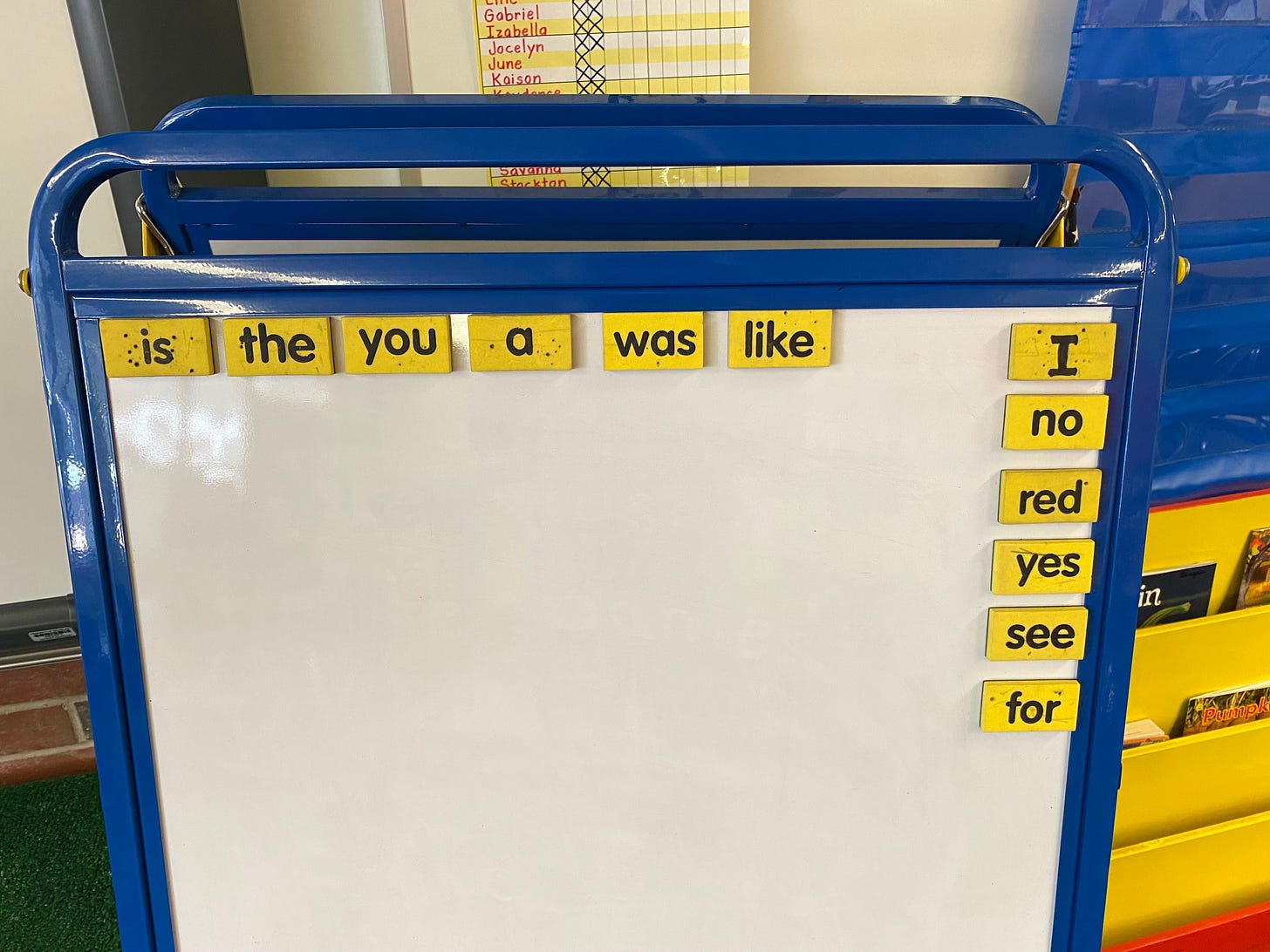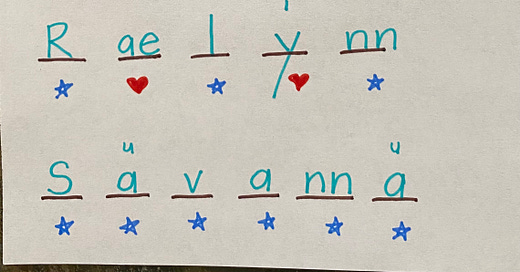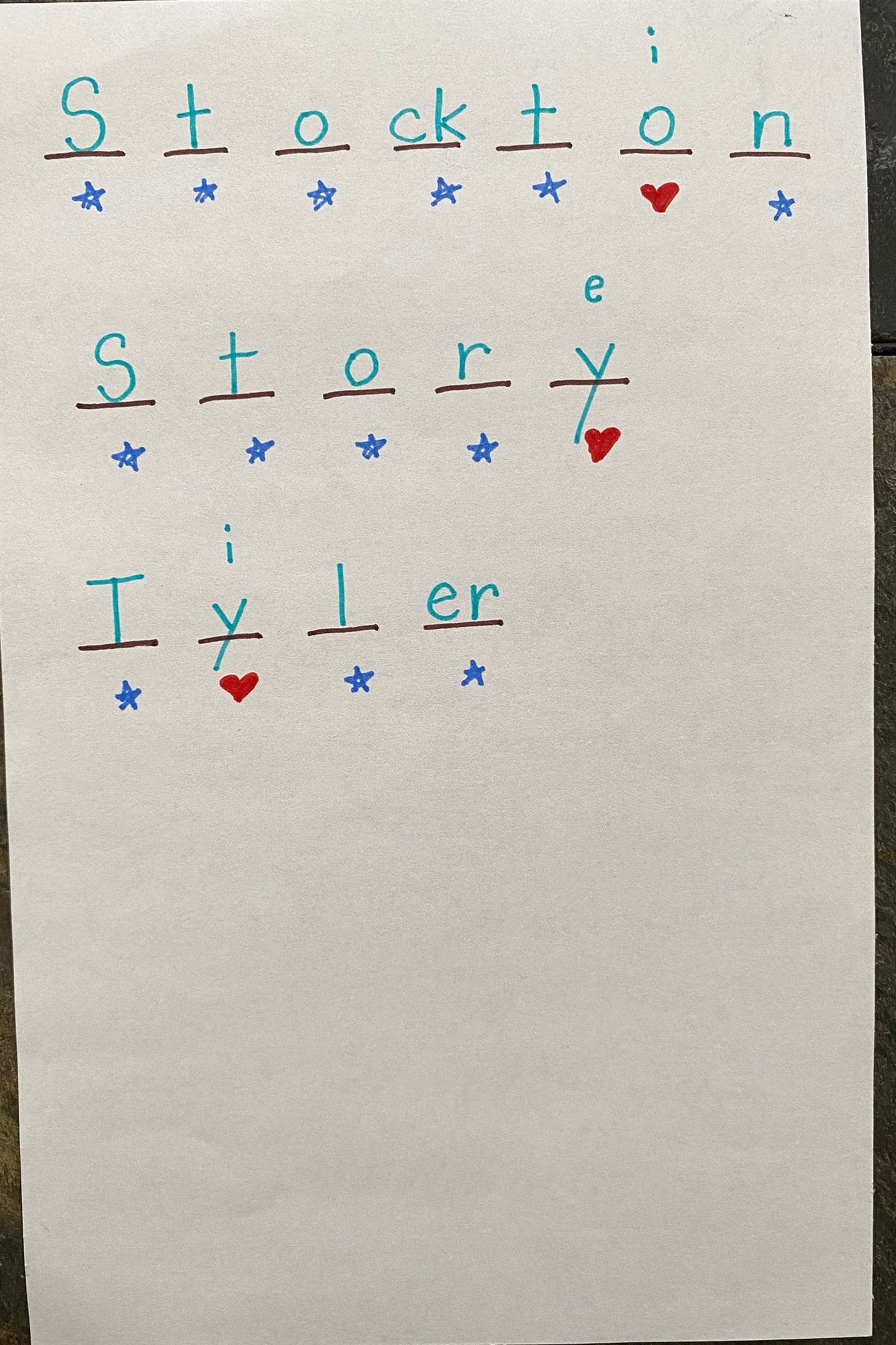Easing Kindergartners into Heart Words
Most of us have figured out that we don’t need to do anything special with all those regular (i.e., decodable) high frequency words. We can just let students decode them as they come across them. Systematic and explicit phonics instruction required, of course.
But what about those irregular high frequency words, the ones that don’t follow the rules, the ones also known as heart words because they have “hard parts to remember by heart”? Most of us used to teach them by flashing them over and over or sending lists home so parents could help their kids memorize the words. Now that we know more about how students learn words, we need to change up our instruction. But how? And where to start?
I first learned about orthographic mapping and how students learn words last spring. I also learned about heart words and experimented some with presenting them to my students and explaining which part of each word would get a heart and why. It was easy last spring because my students were strong in phonemic awareness and already knew a lot of phonics. They could easily understand why the ai in said needed a heart under it. Because ai is not a way to spell the short e sound that they could clearly hear. And they got why the word one needed two hearts at the beginning (where’s the w? and o is making a u sound) and a heart at the end because the silent e isn’t doing its usual thing.
But to have these discussions in October? Impossible. Heck, I don’t even want to tell them yet that sometimes a makes the u sound because they are just now getting so confident in making their screaming sound every time they see an a. But, in order to teach a and the, two very important first high frequency words, I do need to tell them something. Again, how? And when? It’s not like we can wait till spring to start introducing irregular high frequency words.
Because I know I had to get started with heart words sooner rather than later, I decided to just START. Here are some things I’ve been doing.
Introduce hearts with student names during The Name Game
If you’re new here and don’t know much about The Name Game then you can read about it here. It’s a highly engaging and effective way to work on phonemic awareness and phonics. And now I’m using it to introduce the concept of the heart—that it indicates a “hard part to remember by heart.” In the post I linked to above, which I wrote on August 11, I found a paragraph that says:
The Name Game is also an opportune time to bring in the concept of the heart. Think heart words. If we’re going to put a heart under the “hard part to remember by heart” of irregular words, we can do the same with student names. I used to put a star under the letters that were behaving and, in contrast, do nothing with the letters that were misbehaving (not saying their typical sound); now, instead, I’ll put a heart under any sound in the name that isn’t represented by one of the sound’s graphemes. To say it another way, I’m going to draw students’ attention to the parts of the name that are hard (by putting a heart) whereas the stars that I used to use put emphasis on the easy parts of the name.
There are two big questions you might have at this point. First, how do we decide what parts of names get hearts? Can we really analyze names, especially the ones that are spelled really weird? The answer is yes. All you have to do is count the phonemes you hear, draw that many lines on the board, and then start thinking about which graphemes (letters) are used to spell each sound. Yes, sometimes there are missing graphemes and sometimes there are extra graphemes, but there are ways to note these. After that, decide if each grapheme used makes sense (put a star under it) or doesn’t make sense (put a heart under it).
Here comes the next big question. What if the grapheme used does make sense because it’s a common phonics rule but it doesn’t make sense to kindergartners because they haven’t learned that phonics rule yet? Well, there are two ways you can handle this. You could put a heart under something as common as ay making the long a sound. It would sound something like this:
“That’s weird, kids! It sounds like we just need an a, but for some reason there’s an a and a y together. Let’s put a heart under it.”
Or, you could take the opportunity to very briefly introduce the phonics used in the name.
“I know that all we can hear is an a sound right here, but sometimes a and y work together and say a. We’ll learn more about this later, but these letters are actually doing what they’re supposed to be doing, so let’s put a star under them.”
I find myself doing the latter. This approach:
shows more understanding and respect for the way a name is spelled, which is preferable if you’re concerned these conversations might make students worry about their names being spelled “wrong.”
allows you to mention some phonics rules of which your higher students will take note and many others will start noticing in words.
assures that the parts of the names that get stars and hearts remains consistent each time the name is analyzed, whether you’ve formally taught certain phonics or not.
Now, I only put a star under the more advanced phonics if they are something that I plan on teaching my students at some point during the year. For example, I do teach sh and ai so you’ll see them starred. I do not, however teach ie when we’re learning about the long e sound and I do not teach ae for the long a sound (too much for kindergarten), so I’m hearting those now and for the rest of the school year.
I do teach silent e, but I am hearting it for now. I try to avoid talking about long vowels as much as possible before mid-year DIBELS testing because if the students become aware of them they’ll use them any day over the short vowel sounds since they’re so much easier. So, you’ll see silent e hearted for now in my students’ names.
See photos below for examples. I have fairly common and regularly-spelled names this year. I know that there are many “creatively” spelled names out there. You can still work with them. Trust me, I’ve had many over the years.
You can tell from my mistakes in writing these that I still have to think quite a bit about what is used to spell each sound and whether it’s regular or irregular. So don’t worry if it’s not coming to you easily or happening automatically. If it’s tricky for you that does not necessarily mean that it’s too hard for your students to understand. Mine are picking up on it pretty quickly!
My routine for this activity is:
Choose the special helper for the day. In our class, the special helper is called the Busy Bee.
Count the number of phonemes in the student’s name. “Watch me, please. My turn. I’m going to count how many sounds are in _________’s name.” I say each sound, putting up one finger for each sound. “Now, let’s count the sounds in this name together.” Students count on their fingers while we say the sounds together. “Okay, Busy Bee, your turn to count the sounds in your name all by yourself.”
I draw lines on the white board to match the number of sounds in the name.
Then, we map letters onto the sounds. “Who wants to tell me the first sound you hear in this name and what letter you think we’ll use to spell that sound?” Repeat for each sound.
Determine which grapheme makes sense for the sound it is representing and put a star under those and which does not and put a heart under those. “We put a C for the /k/ sound; does that make sense?” “Here, we can see an o was used for the /i/ sound.” (It’s actually a schwa, but I don’t talk about schwa in kindergarten.) “What do you think? Does this make sense or should we put a heart under it?” I sometimes quickly introduce new phonics. “Let’s see, we have an a and an r working together to say /ar/. Kids, that really is how you make the /ar/ sound. It’s different than an r for /r/. A and r can work together, so I’ll give them a star.”
This was a bit painful at first, but after a couple of weeks, my students were calling out “star” and “heart” before I could even ask the question about a particular letter. I began to realize that they had the concept of heart—not the typical grapheme to use in a particular instance so thus a “hard part to remember by heart!” I now knew that teaching heart words would be easier.
The point then is to start by teaching what the heart means rather than start by teaching heart words.
Use the heart word slide show to establish a routine for thinking about, practicing, and mapping heart words
I created this heart word slide show last spring and my students—who had had seven months of phonics instruction and application—did quite well with it and the routine I established for using it. But, again, I had to think about how I might use this with beginning readers who don’t know many phonics at this point.
Though early in the year for understanding why a word is considered a heart word as well as understanding why certain letters get hearts, I want my students to learn this practice routine. So, we have started doing a few slides once or twice a week for the heart words that have been introduced. So far, the words are the, a, is, you, to, and was. The practice routine is as follows:
Show the word by itself and say, “The word is ______. What’s the word?” Click to the next slide.
2. Click again to make the word appear. “What’s this word?” Sometimes call on individual students to keep them engaged and accountable. “How many sounds are in this word?” Help students count the number of sounds in the word.
3. Click to make the graphemes that represent the phonemes appear. “How do we spell _____?” “What letter do we use to spell the first sound?” Repeat for each sound. Mix it up; don’t always ask the sounds in order. If students cannot answer the hard part or don’t remember, draw their attention to the correct spelling of the word (shown above the phoneme segmentation).
4. Click to make the word appear again. Say, “What’s the hard part to remember by heart?” Sometimes call on individual students to keep them engaged and accountable. Click to make the heart appear. Repeat this question if the word has two or three hard parts to remember by heart.
Display the heart words that have been introduced
I’m sure many of you have a better system of doing this than I do, but this is mine for now. I have the heart words I’ve introduced displayed across the top of the easel in our main gathering area. The students can look at these any time while waiting for teaching to begin and refer to them during whole group writing time. I also have each student read a word before being dismissed to get their backpack at the end of the day.

There are other ways I am incorporating heart words into the students’ learning. I am using them on continuous text sheets I make for small group instruction that go into their reading folders. Sometimes students practice reading and writing them at Miss Lori’s center. They like drawing the hearts under the hard parts to remember by heart. Of course they’ll appear in any writing of continuous text we do. I am happy at this point that I am hearing students say things like, “That’s a heart word,” or “That’s the hard part to remember by heart in her name,” or “I better put a heart right here.”
Remember, the goal is to help students understand the sounds in these words (phonemic awareness), which graphemes are being used to represent those sounds, and whether the use of each grapheme makes sense to them or is a hard part to remember by part. This will help students orthographically map these words rather than just memorize them. By mapping them, they’ll learn to spell them faster and more solidly.
So, I hope you’re getting started somehow, some way. Let me know what’s working for you.












